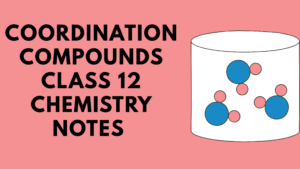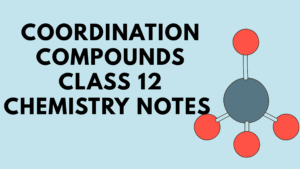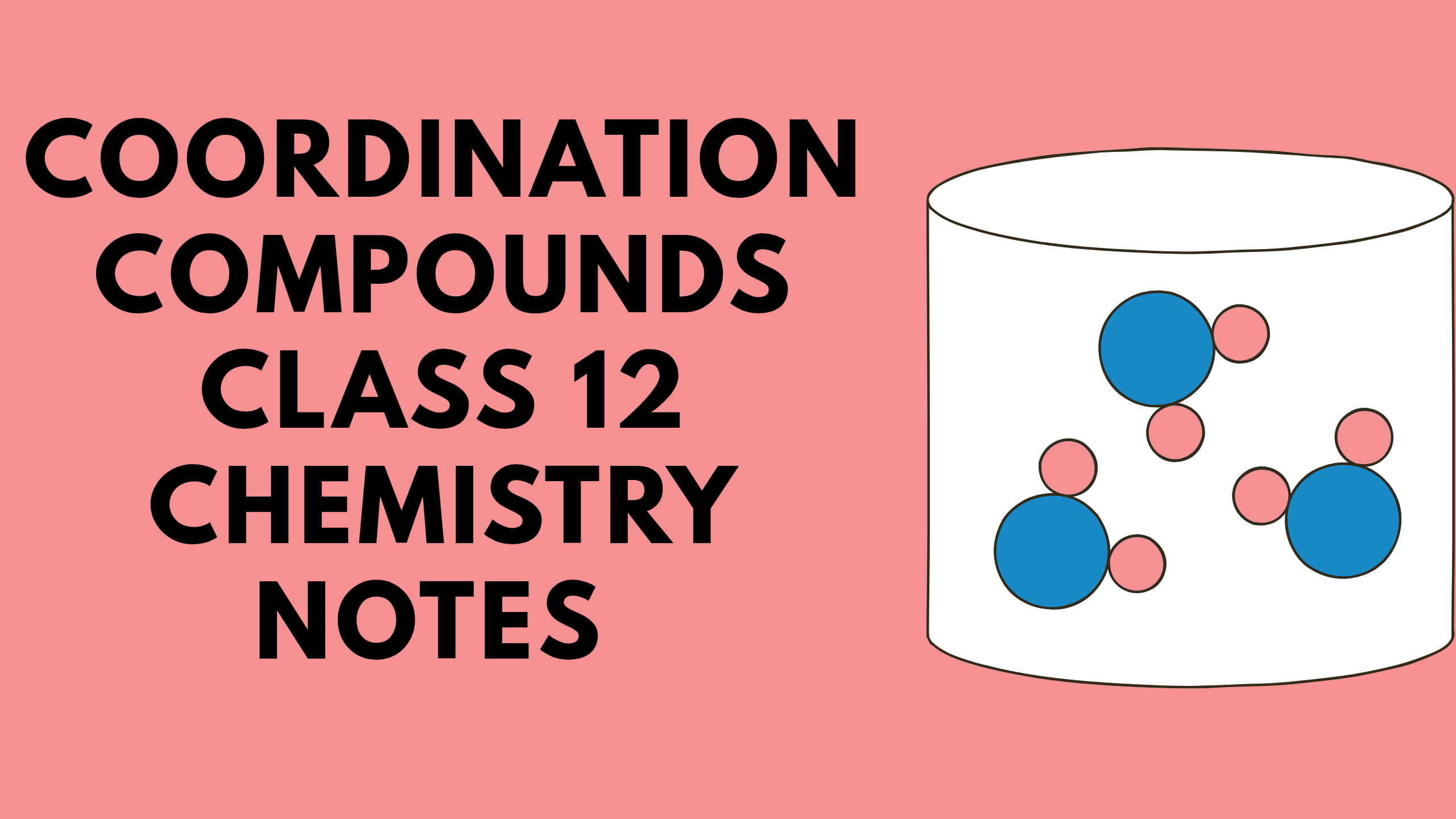Coordination compounds are chemical species in which a central metal atom or ion is surrounded by a set of molecules or anions known as ligands. These ligands donate a pair of electrons to the central metal ion, forming coordinate covalent bonds. Coordination compounds are extremely important in biological systems, industrial applications, and analytical chemistry.
Examples:
- [Fe(CN)₆]³⁻ → Hexacyanoferrate(III) ion
- [Cu(NH₃)₄]²⁺ → Tetraamminecopper(II) ion
- [Co(NH₃)₆]³⁺ → Hexaamminecobalt(III) ion
Applications include catalysis, metallurgical processes, dyes, medicines, and even photography.

Coordination Compounds Class 12 Chemistry Notes | Detailed Explanation & MCQs
Key Terms in Coordination Chemistry
Central Metal Atom/Ion
- A transition metal ion or atom forms the center of the coordination complex.
- It accepts electron pairs from ligands and acts as a Lewis acid.
- Example: Co³⁺ in [Co(NH₃)₆]³⁺.
Ligands
- Molecules or ions donating lone pair electrons to the central metal ion.
- Classified as:
- Monodentate Ligands: Attach through one donor atom, e.g., NH₃, Cl⁻.
- Bidentate Ligands: Attach through two donor atoms, e.g., C₂O₄²⁻ (oxalate), en (ethylenediamine).
- Polydentate Ligands: Attach through multiple donor atoms, e.g., EDTA (hexadentate).
| Type of Ligand | Example | Denticity |
|---|---|---|
| Monodentate | NH₃, Cl⁻ | 1 |
| Bidentate | en, C₂O₄²⁻ | 2 |
| Polydentate | EDTA | 6 |
Coordination Number
- The number of ligand donor atoms attached directly to the central metal ion.
- Example: [Co(NH₃)₆]³⁺ → Coordination number = 6.
Coordination Sphere
- The central metal atom and ligands are collectively enclosed in square brackets [ ].
- Outer sphere components are counterions, e.g., Cl⁻ in [Co(NH₃)₆]Cl₃.
Oxidation Number
- Charge on the central metal ion after removing ligands and electron pairs.
- Example: [Co(NH₃)₅Cl]Cl₂ → Oxidation state of Co = +3.
Werner’s Theory of Coordination Compounds
Proposed by Alfred Werner in 1893:
- Metals exhibit Primary Valency (oxidation state) satisfied by negative ions; written outside brackets.
- Metals exhibit Secondary Valency (coordination number) satisfied by ligands; written inside brackets.
- Secondary valency is fixed for a metal ion.
Example: [CoCl₃·6NH₃]
- Primary valency: 3 (Cl⁻ ions)
- Secondary valency: 6 (NH₃ ligands)
IUPAC Nomenclature Rules
- Cation named first, then anion.
- Ligands named alphabetically before the metal.
- Anionic ligands → name ends in ‘-o’: Cl⁻ → chloro, CN⁻ → cyano.
- Neutral ligands → common names: H₂O → aqua, NH₃ → ammine, CO → carbonyl.
- Oxidation state of metal in Roman numerals.
Example: [Co(NH₃)₅Cl]Cl₂ → Pentaamminechloridocobalt(III) chloride.
Isomerism in Coordination Compounds
Structural Isomerism
- Ionisation Isomerism: Same complex, different ions in solution.
- Hydrate Isomerism: Differ in water molecules inside/outside the coordination sphere.
- Coordination Isomerism: Ligands exchanged between metal ions in a complex.
- Linkage Isomerism: Ambidentate ligands attach via different donor atoms.
Stereoisomerism
- Geometrical Isomerism: Different spatial arrangements of ligands, e.g., cis/trans.
- Optical Isomerism: Non-superimposable mirror images, d- and l- forms.
Example: [Pt(NH₃)₂Cl₂] → Cisplatin (cis) & Transplatin (trans).
Bonding Theories
Valence Bond Theory (VBT)
- Metal ion hybridises orbitals to form coordinate bonds.
- Types of hybridisation:
- sp³ → Tetrahedral
- d²sp³ → Octahedral (inner orbital)
- sp³d² → Octahedral (outer orbital)
Crystal Field Theory (CFT)
- Considers ligands as point charges.
- Explains colour, magnetic properties, and stability.
- d-orbitals split into:
- t₂g (lower energy)
- eₙ (higher energy)
- Δ = Crystal Field Splitting Energy.
Stability of Coordination Compounds

Factors affecting stability:
- Charge on metal ion → Higher charge = stronger complex.
- Chelate effect → Chelating ligands increase stability.
- Nature of ligand → Strong field ligands form stable complexes.
Applications
- Biological Systems: Hemoglobin (Fe²⁺), Vitamin B₁₂ (Co³⁺)
- Medicines: Cisplatin used in cancer treatment.
- Analytical Chemistry: EDTA titrations.
- Industrial Catalysts: Wilkinson’s catalyst in hydrogenation.
Important Reactions
- Substitution Reactions: Ligand replacement.
- Chelation Reactions: Formation of stable chelate rings.
- Redox Reactions: Oxidation/reduction at metal center.
Summary Table
| Concept | Key Points |
| Central Metal Ion | Lewis acid, accepts electron pairs |
| Ligands | Monodentate, Bidentate, Polydentate |
| Coordination Number | No. of ligand donor atoms |
| Isomerism Types | Structural, Geometrical, Optical |
| Bonding Theories | VBT (Hybridisation), CFT (Orbital splitting) |
| Applications | Medicine, Biology, Catalysis, Analysis |
Objective Questions-Coordination Compounds Class 12 Chemistry Notes
Q1. The coordination number of Co in [Co(NH₃)₆]³⁺ is:
A) 3
B) 4
C) 5
D) 6
Answer: D) 6. The complex has six NH₃ ligands attached to Co³⁺.
Q2. The ligand in [Cu(NH₃)₄]²⁺ is:
A) NH₃
B) Cu²⁺
C) Cl⁻
D) H₂O
Answer: A) NH₃. Ammonia donates electron pairs to Cu²⁺.
Q3. The oxidation state of Fe in [Fe(CN)₆]³⁻ is:
A) +2
B) +3
C) 0
D) -3
Answer: B) +3. Each CN⁻ = -1; total -6, net -3, so Fe = +3.
Q4. Werner’s theory explains:
A) Hybridisation
B) Valency
C) Isomerism
D) Geometry
Answer: B) Valency. It introduced primary and secondary valencies.
Q5. Ionisation isomerism occurs due to:
A) Different counter ions
B) Geometry change
C) Oxidation change
D) Ligand denticity
Answer: A) Different counter ions inside or outside the coordination sphere.
Q6. Cisplatin is:
A) Trans isomer
B) Geometrical isomer
C) Optical isomer
D) None
Answer: B) Geometrical isomer. Cis/trans forms differ in ligand positions.
Q7. Strong field ligands produce:
A) Small Δ
B) Large Δ
C) No splitting
D) None
Answer: B) Large Δ. They cause high crystal field splitting energy.
Q8. EDTA is:
A) Monodentate
B) Bidentate
C) Hexadentate
D) Tridentate
Answer: C) Hexadentate. It has six donor atoms to form stable chelates.
Q9. The hybridisation in [Ni(CN)₄]²⁻ (square planar) is:
A) sp³
B) dsp²
C) d²sp³
D) sp³d²
Answer: B) dsp². Square planar complexes use dsp² hybrid orbitals.
Q10. Linkage isomerism arises due to:
A) Geometry
B) Counter ion
C) Ambidentate ligands
D) Oxidation state
Answer: C) Ambidentate ligands attach via different atoms.
Q11. The formula for potassium hexacyanoferrate(II) is:
A) K₄[Fe(CN)₆]
B) K₃[Fe(CN)₆]
C) K₂[Fe(CN)₆]
D) K[Fe(CN)₆]
Answer: A) K₄[Fe(CN)₆]. Potassium balances the -4 charge of the complex.
Q12. Geometry of [Co(NH₃)₆]³⁺ is:
A) Square planar
B) Octahedral
C) Tetrahedral
D) Linear
Answer: B) Octahedral. Six ligands form octahedral geometry.
Q13. The colour of complexes arises due to:
A) Hybridisation
B) d-d transitions
C) Ligand exchange
D) Oxidation
Answer: B) d-d transitions in crystal field splitting.
Q14. Oxidation state of Cr in [Cr(H₂O)₆]³⁺ is:
A) +2
B) +3
C) +4
D) 0
Answer: B) +3. Six H₂O are neutral ligands; charge on Cr = +3.
Q15. Ambidentate ligand example:
A) NH₃
B) SCN⁻
C) H₂O
D) EDTA
Answer: B) SCN⁻. It can bind via sulfur or nitrogen atom.
Q16. Outer orbital complexes use:
A) Inner d-orbitals
B) Outer d-orbitals
C) p-orbitals
D) s-orbitals only
Answer: B) Outer d-orbitals in hybridisation.
Q17. [Ag(NH₃)₂]⁺ is known as:
A) Tollen’s reagent
B) Fehling’s solution
C) Nessler’s reagent
D) None
Answer: A) Tollen’s reagent used in aldehyde tests.
Q18. Low spin complexes occur with:
A) Weak ligands
B) Strong field ligands
C) Monodentate ligands
D) None
Answer: B) Strong field ligands due to large Δ.
Q19. The counter ion in [Co(NH₃)₆]Cl₃ is:
A) NH₃
B) Cl⁻
C) Co³⁺
D) None
Answer: B) Cl⁻. It lies outside the coordination sphere.
Q20. Geometry of [PtCl₄]²⁻ is:
A) Tetrahedral
B) Square planar
C) Octahedral
D) Linear
Answer: B) Square planar with dsp² hybridisation.
Short Answer Questions-Coordination Compounds Class 12 Chemistry Notes
Q1. Define coordination number with an example.
Answer: The coordination number is the number of ligand donor atoms directly bonded to the central metal ion. For example, in [Co(NH₃)₆]³⁺, the coordination number is 6 because six ammonia ligands donate electrons to cobalt.
Q2. What is the difference between primary and secondary valency?
Answer: Primary valency refers to the oxidation state of the metal ion, satisfied by negative ions, while secondary valency refers to the coordination number, satisfied by neutral or negative ligands directly attached to the metal ion.
Q3. Explain optical isomerism in coordination compounds.
Answer: Optical isomerism occurs when two isomers are non-superimposable mirror images of each other, like left and right hands. They rotate plane-polarised light in opposite directions and occur mostly in octahedral complexes with bidentate ligands.
Q4. What is a chelate? Give an example.
Answer: A chelate is a coordination compound in which a ligand forms more than one bond with the metal ion, creating a ring-like structure. Example: [Cu(EDTA)]²⁻, where EDTA forms a stable chelate with copper.
Q5. Write the IUPAC name of [Pt(NH₃)₂Cl₂].
Answer: The IUPAC name is Diamminedichloroplatinum(II). The metal is platinum with two ammine and two chloride ligands.
Long Answer Questions-Coordination Compounds Class 12 Chemistry Notes

Q1. Explain the postulates of Werner’s theory with examples.
Answer: Werner’s theory states that metals exhibit two types of valencies: primary (ionisable) and secondary (non-ionisable). Primary valency corresponds to the oxidation state and is satisfied by negative ions, while secondary valency corresponds to the coordination number and is satisfied by ligands. Example: In [Co(NH₃)₆]Cl₃, three Cl⁻ ions satisfy primary valency, while six NH₃ molecules satisfy secondary valency.
Q2. Describe the Crystal Field Theory (CFT) for octahedral complexes.
Answer: CFT explains the splitting of d-orbitals in a metal ion due to the approach of ligands. In an octahedral field, the five d-orbitals split into two sets: t₂g (lower energy) and e_g (higher energy). The energy difference (Δ₀) determines the colour, magnetism, and stability of the complex. Strong field ligands create a large Δ₀ leading to low spin complexes.
Q3. Discuss different types of isomerism in coordination compounds with examples.
Answer: Isomerism includes structural isomerism (ionisation, linkage, coordination, hydrate) and stereoisomerism (geometrical, optical). For example, linkage isomerism occurs in [Co(NO₂)(NH₃)₅]Cl₂ where NO₂⁻ can bind through N (nitro) or O (nitrito).
Q4. Explain the applications of coordination compounds in biology and industry.
Answer: Coordination compounds like hemoglobin and chlorophyll are essential for oxygen transport and photosynthesis. Industrially, complexes like Wilkinson’s catalyst [RhCl(PPh₃)₃] are used in hydrogenation, and silver complexes in photography.
Q5. Describe the hybridisation and geometry of [Ni(CN)₄]²⁻ and [Co(NH₃)₆]³⁺.
Answer: [Ni(CN)₄]²⁻ has dsp² hybridisation leading to square planar geometry due to strong field CN⁻ ligands causing pairing of electrons. [Co(NH₃)₆]³⁺ has d²sp³ hybridisation forming octahedral geometry with six ligands surrounding the metal ion.
Conclusion
Coordination compounds form the backbone of many chemical, biological, and industrial processes. Their unique structures, bonding theories, and versatile applications make them one of the most fascinating areas of inorganic chemistry. A solid understanding of concepts like isomerism, bonding theories, and stability factors not only helps in academics but also builds a foundation for advanced studies in chemistry, medicine, and materials science.
Class 12 Chemistry Notes – Biomolecules | Complete Explanation with Questions
